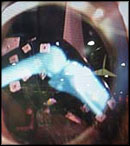
|
Virtual
Reality Dynamic Anatomy(VRDA)(1990-present)
The Virtual Reality Dynamic
Anatomy (VRDA) framework was initiated in 1997 which combined
research in augmented reality, optical tracking, head-worn
displays, and computer vision developed in our laboratory to
perform dynamic optical superimposition of internal organs on
the human body. The VRDA project first investigated the optical
superimposition of bony knee joint on a human knee in motion,
research featured in Scientific America in an article by Steve
Feiner and also CNN-online. Videos of this work can be found
under images & movies on our site.
Additional References
Yohan Baillot, First Implementation of the Virtual Reality Dynamic Anatomy Tool, M.S. Thesis, University of Central Florida (1999)
|

